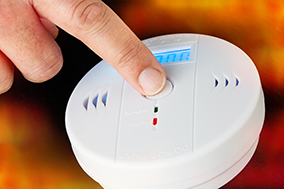
When it comes to home fire safety, a little preparation and precaution go a long way toward ensuring your family, your home, and your valuables are protected. Consider the following important tips.
Home Fire Safety Tip #1: Fires and Fire Extinguishers
Fires are classified into different types. The type depends on the material burning. Fire extinguishers are similarly classified to match the type of burning materials they are designed to extinguish.
There are 5 types of fire extinguishers:
- A Class: Ordinary combustibles such as paper, wood, rubbish, drapes and upholstery.
- B Class: Flammable liquids such as gasoline, oils, solvents, paints and flammable gases.
- C Class: Electrical fires involving Class “A” or Class “B” materials and live electrical power – overheated wiring, fuse boxes, stoves, motors etc.
- D Class: Combustible metal fires. Magnesium and Titanium are the most common types of metal fires. Once a metal ignites do not use water in an attempt to extinguish it.
- K Class: Fires that involve cooking oils, grease or animal fat and can be extinguished using Purple K, the typical agent found in kitchen or galley extinguishers.
Since residential fires can involve any type of material, every home should have at least one multi-purpose ABC fire extinguisher that is easy to use.
In addition, if you store chemicals, get an extinguisher designed for that specific chemical. This will help to ensure that no adverse reaction is caused by the mixture of the burning chemical with the fire extinguisher solution. For example, a poisonous gas is produced when chlorine comes in contact with ammonia. Ammonia is found in most Class A extinguishers.
Remember to position your fire extinguishers near cooking areas, fireplaces and other likely sources of fire. They also need to be inspected and replaced according to safety guidelines.
Home Fire Safety Tip #2: Security Precautions, Prevention and Protection
It is wise to do whatever you can to protect your family and valuables by preventing fires, rather than only reacting to them.
Experts urge all homeowners to discourage smoking indoors, especially in bedrooms. They also urge you to be wary of purchasing flammable fabrics and furnishings, or unsafe, unapproved building materials.
Also, you should ensure that your priceless valuables and critical financial records are kept in a fire-proof safe or that you keep copies of critical documents elsewhere. As the saying goes, an ounce of prevention is worth a pound of cure.
Home Fire Safety Tip #3: Smoke Detectors
There should be at least one smoke detector on every floor of your home. If you have a large home you should install one outside of each bedroom.
If any resident is hearing-impaired, consider strobe-light alarms.
To avoid false alarms, only use smoke detectors designed for specific areas. Ionization types are best for bedroom areas, and less sensitive photo-electric detectors are better for the kitchen.
Some building and safety codes require hard-wired detectors that are permanently connected to AC power, with back-up battery power.
Keep all smoke detectors dust-free, and don’t paint them. Remember to test and replace the batteries regularly, and note the units’ expiry dates.
Home Fire Safety Tip #4: Have an escape route planned
You may have less than one minute to escape a fire in your home. If a fire starts in your home a planned route can help reduce panic and confusion.
Draw a floor plan of your home showing all possible exits from each room. Plan a main escape route and an alternate escape route from each room, especially bedrooms.
Choose an outside meeting place and a safe location to call 9-1-1. The best place to meet is in front of your home, where firefighters will arrive.
Make sure to practice your home fire escape plan at least two times every year.
Keep all exits in the home clear and easy to use.
Don’t go back inside. Once outside and at the designated meeting place, no one re-enters the burning house. Firefighters are equipped and trained to handle rescue operations and they will let you know when it is safe to go back into the house. Get out and stay out!